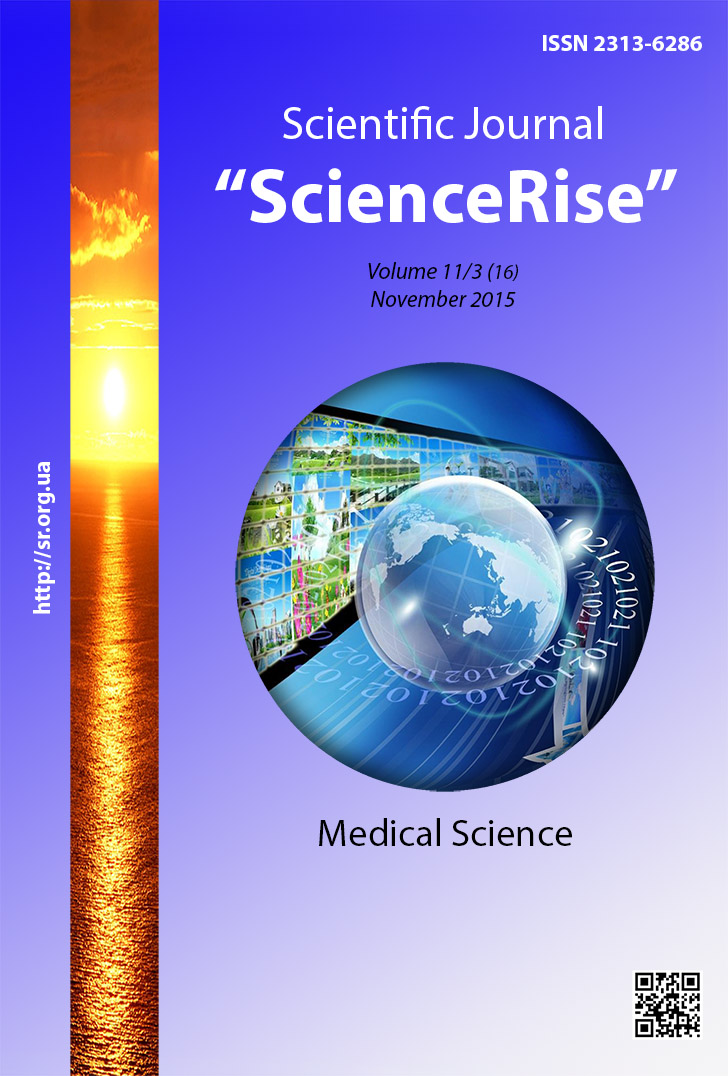Value of the spiral computed tomography in detecting severity of bronchopulmonary dysplasia in infants and newborns
DOI:
https://doi.org/10.15587/2313-8416.2015.54624Keywords:
bronchopulmonary dysplasia, infants, chest organs, newborns, spiral computed tomographyAbstract
For today the bronchopulmonary dysplasia is polyetiological chronic disease of morphologically immature lungs that develops in newborns especially extremely premature ones as a result of intensive care of respiratory distress-syndrome and\or pneumonia.
The aim of research: improvement of BPD diagnostics by the study of SCT image of chest organs and elaboration of criteria of injury severity.
Materials and methods. There were analyzed the data of SCT of chest organs CO) of 42 patients with BPD (28 boys, 14 girls) 25 days – 3 years old. 34 (81,0 %) were premature (19,0 %) – mature.
Results. The radiographic criteria of BPD severity are: an intensity of pulmonary vasculature changes (from the local moderate one to diffuse pneumofibrosis), pulmonary hyperpneumatosis, emphysematous bullas (isolated or multiple), the pulmonary hypertension and pleuro-diaphragm, pleuro-pericardial commissures.
Conclusions. SCT allows reveal the early signs of pulmonary changes at BPD and detect its severity that influences on the choice of treating tactics. With the help of SCT it is possible to establish the combination of BPD with anomalies and development disorders of lungs that detect its further prognosis and life quality
References
Babak, O. A., Voroncova, Ju. N., Geppe, N. A. (2010). Bronholegochnaja displazija. Moscow: Izdatel'stvo GOU VPO RGMU Roszdrava, 56.
Ovsjannikov, D. Ju.; Kuz'menko, L. G. (Ed.) (2010). Sistema okazanija medicinskoj pomoshhi detjam, stradajushhim bronholegochnoj displaziej. Moscow: MDV, 152.
Northway, W. H., Rosan, R. C., Porter, D. Y. (1967). Pulmonary Disease Following Respirator Therapy of Hyaline-Membrane Disease. New England Journal of Medicine, 276 (7), 357–368. doi: 10.1056/nejm196702162760701
Bancalari, E., Claure, N., Sosenko, I. R. (2003). Bronchopulmonary dysplasia: changes in pathogenesis, epidemiology and definition. Seminars in Neonatology, 8 (1), 63–71. doi: 10.1016/s1084-2756(02)00192-6
Jobe, A. H., Bancalari, E. (2001). Bronchopulmonary dysplasia. Аm. J. Respir. Crit. Care Med., 163 (7), 1723–1729.
Baranova, A. A., Namazovoj-Baranovoj, L. S., Davydovoj, I. V. (Ed.) (2013). Sovremennye podhody k profilaktike, diagnostike i lecheniju bronholegochnoj displazii. Moscow: Pediatr, 176.
Ehrenkranz, R. A. (2005). Validation of the National Institutes of Health Consensus Definition of Bronchopulmonary Dysplasia. PEDIATRICS, 116 (6), 1353–1360. doi: 10.1542/peds.2005-0249
Spuzjak, M. I., Shapovalova, V. V., Voron'zhev, I. O. (2009). Zminy v legenjah pry bronholegenevij dysplazii' u ditej za danymy komp`juternoi' tomografii'. Ukrai'ns'kyj radiologichnyj zhurnal, 2, 146–151.
Cygina, E. N., Davidov, I. V., Kustova, O. V. (2008). Radiologicheskie issledovanija pri bronholegochnoj displazii u detej. Medicinskaja vizualizacija, 2, 116–121.
Aquino, S. L., Schechter, M. S., Chiles, C., Ablin, D. S., Chipps, B., Webb, W. R. (1999). High-resolution inspiratory and expiratory CT in older children and adults with bronchopulmonary dysplasia. American Journal of Roentgenology, 173 (4), 963–967. doi: 10.2214/ajr.173.4.10511158
Aukland, S. M., Rosendahl, K., Owens, C. M., Fosse, K. R., Eide, G. E., Halvorsen, T. (2009). Neonatal bronchopulmonary dysplasia predicts abnormal pulmonary HRCT scans in long-term survivors of extreme preterm birth. Thorax, 64 (5), 405–410. doi: 10.1136/thx.2008.103739
Mahut, B., De Blic, J., Emond, S., Benoist, M.-R., Jarreau, P.-H., Lacaze-Masmonteil, T. et. al (2007). Chest computed tomography findings in bronchopulmonary dysplasia and correlation with lung function. Archives of Disease in Childhood – Fetal and Neonatal Edition, 92 (6), F459–F464. doi: 10.1136/adc.2006.111765
Frush, D. P., Donnelly, L. F., Rosen, N. S. (2003). Computed Tomography and Radiation Risks: What Pediatric Health Care Providers Should Know. PEDIATRICS, 112 (4), 951–957. doi: 10.1542/peds.112.4.951
Downloads
Published
Issue
Section
License
Copyright (c) 2015 Вікторія Вікторівна Шаповалова

This work is licensed under a Creative Commons Attribution 4.0 International License.
Our journal abides by the Creative Commons CC BY copyright rights and permissions for open access journals.
Authors, who are published in this journal, agree to the following conditions:
1. The authors reserve the right to authorship of the work and pass the first publication right of this work to the journal under the terms of a Creative Commons CC BY, which allows others to freely distribute the published research with the obligatory reference to the authors of the original work and the first publication of the work in this journal.
2. The authors have the right to conclude separate supplement agreements that relate to non-exclusive work distribution in the form in which it has been published by the journal (for example, to upload the work to the online storage of the journal or publish it as part of a monograph), provided that the reference to the first publication of the work in this journal is included.

